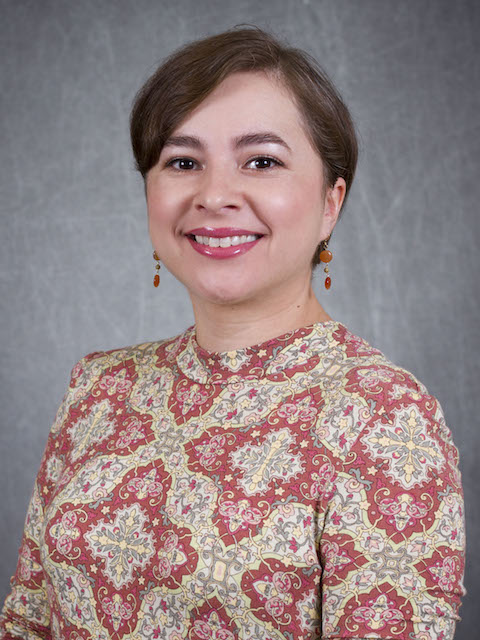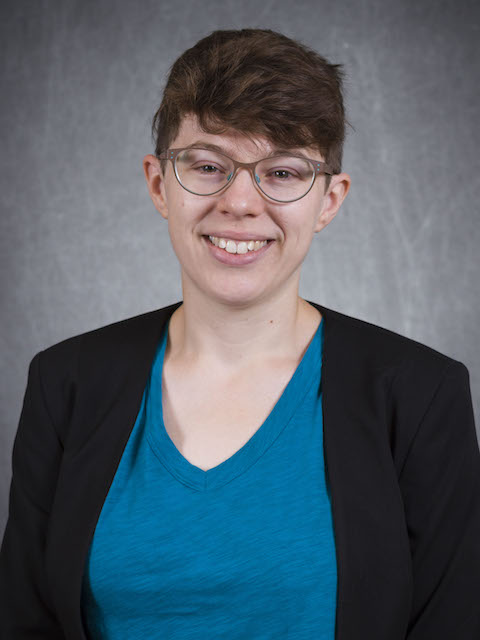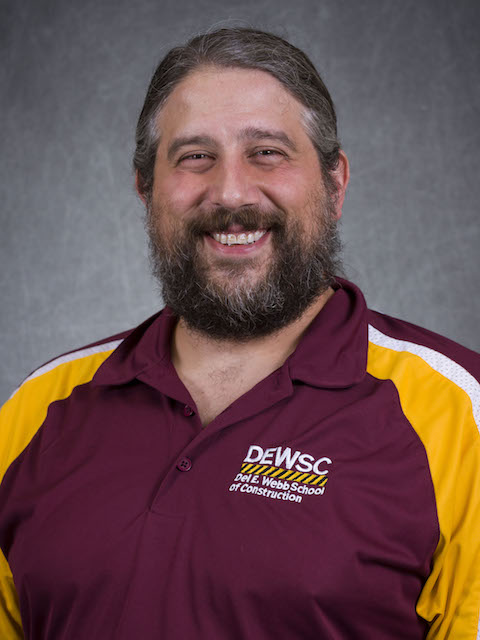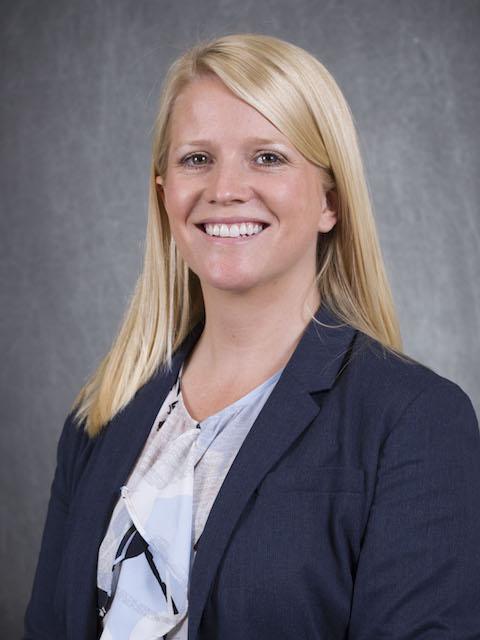
Anca Delgado
Anca Delgado, Assistant Professor
PhD, Arizona State University
Anca Delgado is new to the faculty of the Ira A. Fulton Schools of Engineering but certainly not to Arizona State University.
She enrolled as an undergraduate in 2008, after more than a year of studying philology in college in her native country of Romania.
But she changed course after coming to ASU, when she “fell in love” — with microbiology.
In a part-time job with a veterinary hospital during her undergrad years, she discovered “that I like doing lab work,” and she found it intriguing to learn about the biology involved in diagnosing and treating diseases that afflict animals.
Those interests led her to pursue a doctoral degree in microbiology, which in turn got her connected with Fulton Schools Associate Professor Rosa Krajmalnik-Brown and ASU’s Swette Center for Environmental Biotechnology, directed by Fulton Schools Professor Bruce Rittmann.
Her performance in the doctoral program kept her at the Swette Center, first as a postdoctoral environmental engineering research assistant and then as an assistant research scientist.
As a doctoral student and postdoc she also taught Introduction to Environmental Engineering (CEE 361) as well as microbiology courses. Now as an assistant professor, Delgado is teaching a course in contaminant fate and transport in the environment, one of the core courses in the environmental engineering master’s and doctoral programs.
The course material aligns with the thrust of her research, which she describes as “using microorganisms to clean up contaminated soil and water so that we can prevent communities from getting sick, and keep these contaminants from getting into our food sources and our water supplies.”
One focus of her research is on bioremediation of chlorinated solvents, using microorganisms that can essentially respire — literally breathe in — these industrial solvents or alter them into forms that render them no longer chlorinated, toxic or carcinogenic.
Delgado is also developing a course in geoenvironmental engineering for the Fulton Schools’ new undergraduate environmental engineering course. It will examine methods of soil and ground water remediation.
She’s doing microorganism-based geoenvironmental remediation research through a project for the Center for Bio-mediated and Bio-Inspired Geotechnics, a National Science Foundation Center led by the Fulton Schools.
Another project involves working with the energy corporation Chevron to develop more effective ways to remediate soil contaminated with petroleum hydrocarbons — material that was spilled decades ago and is no longer biodegradable. Delgado hopes to find a way to alter the hydrocarbons so that microorganisms can consume them.
Away from her work, Delgado, who grew up on a farm (“We lived off the land,” she says) intends to remain an avid home gardener. She grows citrus trees and a range of vegetables, fruits and herbs.
She and her husband also travel when they can — particularly to Europe — and are fairly frequent concertgoers, especially drawn to music festivals such as the popular annual Coachella Valley Music and Arts Festival in California

Margaret Garcia
Margaret Garcia, Assistant Professor
PhD, Tufts University
Upon graduating from Tufts University with her doctorate in Civil and Environmental Engineering, Margaret Garcia was looking for somewhere to tackle the vital, pressing issues in her field of water resources engineering.
To do so, she believed an interdisciplinary approach was necessary, and she saw ASU was the place to be.
“I was excited about the great interdisciplinary work that I have seen coming out of ASU in recent years… [and] ASU is not just supporting but actively encouraging this kind of work,” says Garcia.
Garcia’s affinity for interdisciplinary work and studies lines up with her field, which spans the connections between the built environment’s infrastructure and residential areas and the natural environment’s various ecosystems and resources.
Her research investigates the factors influencing the sustainability and resilience of urban water supply systems by advancing the theory of coupled systems, translating theory into actionable models, and applying these models to support infrastructure planning and policy analysis.
Garcia’s recent research projects include linking water demand projections to policy choices, assessing the sensitivity of supply models to demand assumptions, and evaluating tradeoffs between robust and flexible approaches to infrastructure design. She is in the process of building a research group that will tackle these and other issues at the intersection of hydrological, infrastructure and social systems.
Though always interested in math and science as a child, it was Garcia’s experience with Engineers Without Borders that was her first exposure to engineering. As a volunteer with the organization, Garcia travelled to Honduras to work on drinking water systems, learning how to survey pipeline routes, size storage tanks and other skills essential to her discipline. However, Garcia notes that many of her lessons with Engineers Without Borders were not strictly technical.
“I learned about developing trust across cultures and about all the different dimensions of sustainability,” she says.
Her two main takeaways from her time volunteering are that “good design is always contextually appropriate — it responds to local problems, needs, resources and skills,” and “collaboration is essential to produce good design — collaboration between engineers and the people that are going to use and manage the system as well as collaboration between engineers and other experts that see different dimensions of the problem and can find different routes to a solution.”
After completing her undergraduate degree, Garcia spent four years working as a civil engineer for the consulting firm Arup. At Arup, Garcia worked on the planning, design and construction administration of infrastructure projects in the U.S. and abroad, which reinforced what she learned during her time with Engineers Without Borders.
Garcia says she hopes pass these lessons learned onto her students through design examples and problems that challenge them to think beyond just the physics and consider how a piece of infrastructure will be utilized by people day-to-day.
“I am excited to be teaching courses on hydrology and infrastructure because the subject never gets repetitive – both the hydrological and human systems are continuously evolving so there is always a new aspect of the system to explore,” says Garcia.
In light of a growing global population and a rapidly changing world, Garcia notes there is no shortage of interesting and important careers and jobs for students to pursue upon graduation.
In her free time, Garcia looks forward to exploring Phoenix’s live music scene. She’s also an avid runner and hiker.
“I’m looking forward to the heat breaking a bit so I can try some of the hiking spots in Southern Arizona,” she added.

Anthony Lamanna
Anthony (Tony) Lamanna, Associate Professor
PhD, University of Wisconsin–Madison
Anthony Lamanna’s teaching career at Tulane University in New Orleans was turned upside down in 2005.
“After a bit of weather called Hurricane Katrina, the university closed its engineering programs,” Lamanna recounts. “After some soul-searching, I decided to stay in New Orleans and start my own engineering firm to assist in rebuilding.”
He also didn’t give up on teaching, taking a side job as an adjunct at the University of New Orleans while he consulted, and in 2013 Lamanna returned to a full-time faculty position at Eastern Kentucky University.
During that time, Lamanna’s dedication to advancing the construction field earned him the election of Fellow of the American Concrete Institute and the American Society of Civil Engineers, and commission as a Kentucky Colonel by the Governor of Kentucky, the state’s highest civilian honor.
In 2017, he was drawn to ASU by the inclusiveness of the ASU charter and the university’s willingness to try new and innovative things.
“I think I can make a big difference here,” says Lamana, who also will be Program Chair of the Del E. Webb School of Construction and Sundt Professor of Alternative Delivery Methods and Sustainable Development.
He brings his expertise in building repair, rehabilitation, retrofit and adaptive reuse — also known as “hardening” of buildings, or making them more resilient to hazards such as high winds, storm surge, earthquakes, fires or blast.
“While I studied retrofit of bridges during my PhD work, the area didn’t become my specialty until after Hurricane Katrina when I was put in the water, both literally and figuratively,” Lamanna says.
This semester, Lamanna is teaching ASU 101 for construction management and construction engineering students. He’s excited to be teaching freshmen how to be successful students and develop their skills. His students should be prepared to cover real-life applications as well as theory.
“Part of ‘real life’ is deadlines,” Lamanna says. “Students frequently complain that I don’t take late work or allow make-ups. In the construction industry, if you turn in a bid package one minute late it won’t be considered, and will probably get you fired.”
When he’s not teaching his students how to be successful construction engineers, he’s making homemade wine, mead and beer, and serves as a certified beer judge.

Rebecca Muenich
Rebecca Muenich, Assistant Professor
PhD, Purdue University
Rebecca Muenich’s path to becoming an engineer required her to first realize what an engineer is.
“Honestly, coming from a smaller place than most, until high school I thought engineers were just people driving trains,” Muenich says. “It finally took seeing and hearing a female engineer talking about her experience as an engineer to spark my interest. What keeps me interested is the opportunities that engineering provides in terms of working on complex, interconnected, and interdisciplinary problems.”
The next part of her path in becoming an engineer was choosing the engineering discipline that fit her personal interests. She chose to focus on the field of watershed modeling for surface hydrology and water quality with special focus on agricultural ecosystems.
“I chose this subject because I grew up in a very interesting place: Northwest Arkansas, says Muenich. “During my youth, this area was urbanizing rapidly due to the economic growth induced by Wal-Mart; simultaneously the environmental lawsuit between Oklahoma and Arkansas poultry producers over excess nutrients from poultry farms in the region was playing out.”
From a very young age, Muenich witnessed the impacts of human uses of ecosystems, while enjoying her time exploring the ecosystems of the Natural State.
“I wanted to work on helping people reduce their impacts on ecosystems while maintaining economic productivity, says Muenich. “My current research is focused on evaluating the impacts of land management decisions within the context of the food-energy-water nexus.”
Muenich, who earned a doctoral degree in agricultural biological engineering at Purdue University and worked as a postdoc at the Graham Sustainability Institute at the University of Michigan, was drawn to ASU due in part to the inclusivity statement that is a part of the ASU charter.
“ASU’s reputation for trying new things really appealed to me,” Muenich says. “I wanted to work at a school where I felt I could really make an impact on students.”
Now that she’s at ASU, as an assistant professor in the School of Sustainable Engineering and the Built Environment at the Ira A. Fulton Schools of Engineering, she’s teaching a Geographic Information Systems class for graduate students this semester and will teach an undergraduate class on engineering mechanics in the spring.
“I’m excited to teach the GIS class because I love visualizing and analyzing data,” Muenich says. “I’m excited to help graduate students learn how GIS can help them understand data in their own field/research. The engineering mechanics class will be fundamental for environmental engineers as it teaches them the skills to prepare for hydrology and fluid dynamics, so I’m excited to help students build their engineering foundations.”
Muenich enjoys watching and playing sports such as volleyball, softball and flag football in her free time. She also loves outdoor activities (camping, hiking, kayaking), gardening, traveling, and journaling.